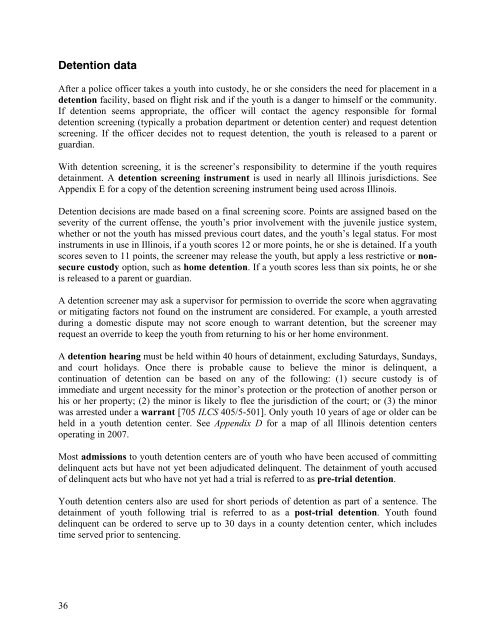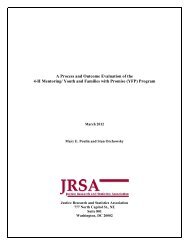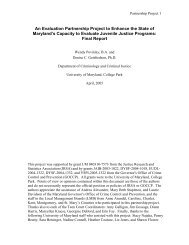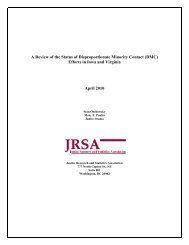Juvenile Justice System and Risk Factor Data - Illinois Criminal ...
Juvenile Justice System and Risk Factor Data - Illinois Criminal ...
Juvenile Justice System and Risk Factor Data - Illinois Criminal ...
Create successful ePaper yourself
Turn your PDF publications into a flip-book with our unique Google optimized e-Paper software.
Detention data<br />
After a police officer takes a youth into custody, he or she considers the need for placement in a<br />
detention facility, based on flight risk <strong>and</strong> if the youth is a danger to himself or the community.<br />
If detention seems appropriate, the officer will contact the agency responsible for formal<br />
detention screening (typically a probation department or detention center) <strong>and</strong> request detention<br />
screening. If the officer decides not to request detention, the youth is released to a parent or<br />
guardian.<br />
With detention screening, it is the screener’s responsibility to determine if the youth requires<br />
detainment. A detention screening instrument is used in nearly all <strong>Illinois</strong> jurisdictions. See<br />
Appendix E for a copy of the detention screening instrument being used across <strong>Illinois</strong>.<br />
Detention decisions are made based on a final screening score. Points are assigned based on the<br />
severity of the current offense, the youth’s prior involvement with the juvenile justice system,<br />
whether or not the youth has missed previous court dates, <strong>and</strong> the youth’s legal status. For most<br />
instruments in use in <strong>Illinois</strong>, if a youth scores 12 or more points, he or she is detained. If a youth<br />
scores seven to 11 points, the screener may release the youth, but apply a less restrictive or nonsecure<br />
custody option, such as home detention. If a youth scores less than six points, he or she<br />
is released to a parent or guardian.<br />
A detention screener may ask a supervisor for permission to override the score when aggravating<br />
or mitigating factors not found on the instrument are considered. For example, a youth arrested<br />
during a domestic dispute may not score enough to warrant detention, but the screener may<br />
request an override to keep the youth from returning to his or her home environment.<br />
A detention hearing must be held within 40 hours of detainment, excluding Saturdays, Sundays,<br />
<strong>and</strong> court holidays. Once there is probable cause to believe the minor is delinquent, a<br />
continuation of detention can be based on any of the following: (1) secure custody is of<br />
immediate <strong>and</strong> urgent necessity for the minor’s protection or the protection of another person or<br />
his or her property; (2) the minor is likely to flee the jurisdiction of the court; or (3) the minor<br />
was arrested under a warrant [705 ILCS 405/5-501]. Only youth 10 years of age or older can be<br />
held in a youth detention center. See Appendix D for a map of all <strong>Illinois</strong> detention centers<br />
operating in 2007.<br />
Most admissions to youth detention centers are of youth who have been accused of committing<br />
delinquent acts but have not yet been adjudicated delinquent. The detainment of youth accused<br />
of delinquent acts but who have not yet had a trial is referred to as pre-trial detention.<br />
Youth detention centers also are used for short periods of detention as part of a sentence. The<br />
detainment of youth following trial is referred to as a post-trial detention. Youth found<br />
delinquent can be ordered to serve up to 30 days in a county detention center, which includes<br />
time served prior to sentencing.<br />
36

















